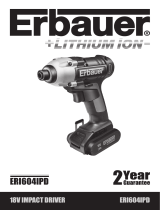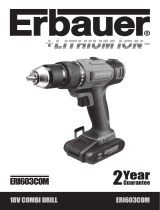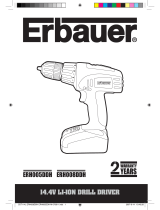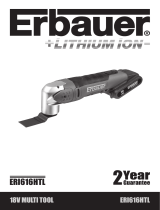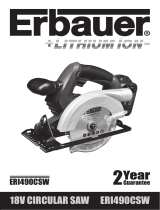Page is loading ...

18V LI-ION TORCH
WARRANTY
YEARS
ERI068TOR


18V LI-ION TORCH
GUARANTEE
This
product carries a guarantee of 24 months. If your product develops a
fault within this period, you should in the first instance contact the retailer where the
item was purchased.
This guarantee specifically excludes losses caused due to:
- Fair wear and tear
- Misuse or abuse
- Lack of routine maintenance
- Failure of consumable items (such as batteries)
- Accidental damage
- Cosmetic damage
- Failure to follow manufacturer’s guidelines
- Loss of use of the goods
This guarantee does not affect your statutory rights. This guarantee is only valid in the UK.
For further technical advice, spare parts or repair service (outside of guarantee) please
contact the customer helpline number on 0845 607 6380
Congratulations on your purchase of a quality power tool from Erbauer (UK)
Ltd. This product should give you reliable service but for your peace of mind
this
power tool does carries a 24-month guarantee, the terms of
which are detailed below.
If this product develops a fault within the guarantee period contact your
retailer.
Please retain this handbook in case you need to refer to safety, care or guarantee
information in the future.

SAFETY INSTRUCTIONS
Warning! Read all safety warnings and all instructions. Failure to follow
the warnings and instructions may result in electric shock, fire and/or serious
injury.
Save all warnings and instructions for future reference.
The term “power tool” in the warnings refers to your mains-operated (corded) power
tool or battery-operated (cordless) power tool.
1. Work area safety
a. Keep work area clean and well lit. Cluttered or dark areas invite accidents.
b. Do not operate power tools in explosive atmospheres, such as in the
presence of flammable liquids, gases or dust. Power tools create sparks
which may ignite the dust or fumes.
c. Keep children and bystanders away while operating a power tool.
Distractions can cause you to lose control.
2. Electrical safety
a. Power tool plugs must match the outlet. Never modify the plug in any
way. Do not use any adapter plugs with earthed (grounded) power tools.
Unmodified plugs and matching outlets will reduce risk of electric shock.
b. Avoid body contact with earthed or grounded surfaces, such as pipes,
radiators, ranges and refrigerators. There is an increased risk of electric shock
if your body is earthed or grounded.
c. Do not expose power tools to rain or wet conditions. Water entering a
power tool will increase the risk of electric shock.
d. Do not abuse the cord. Never use the cord for carrying, pulling or
unplugging the power tool. Keep cord away from heat, oil, sharp edges or
moving parts. Damaged or entangled cords increase the risk of electric shock.
e. When operating a power tool outdoors, use an extension cord suitable
for outdoor use. Use of a cord suitable for outdoor use reduces the risk of electric
shock.
f. If operating a power tool in a damp location is unavoidable, use a
residual current device (RCD) protected supply. Use of an RCD reduces the
risk of electric shock.
3. Personal safety
a. Stay alert, watch what you are doing and use common sense when
operating a power tool. Do not use a power tool while you are tired or
under the influence of drugs, alcohol or medication. A moment of inattention
while operating power tools may result in serious personal injury.
b. Use personal protective equipment. Always wear eye protection.
Protective equipment such as dust mask, non-skid safety shoes, hard hat, or
hearing protection used for appropriate conditions will reduce personal injuries.
c. Prevent unintentional starting. Ensure the switch is in the off-position
before connecting to power source and/or battery pack, picking up
or carrying the tool. Carrying power tools with your finger on the switch or
energising power tools that have the switch on invites accidents.

18V LI-ION TORCH
d. Remove any adjusting key or wrench before turning the power tool on.
A wrench or a key left attached to a rotating part of the power tool may result in
personal injury.
e. Do not overreach. Keep proper footing and balance at all times. This
enables better control of the power tool in unexpected situations.
f. Dress properly. Do not wear loose clothing or jewellery. Keep your hair,
clothing and gloves away from moving parts. Loose clothes, jewellery or
long hair can be caught in moving parts.
g. If devices are provided for the connection of dust extraction and
collection facilities, ensure these are connected and properly used. Use
of dust collection can reduce dust-related hazards.
4. Power tool use and care
a. Do not force the power tool. Use the correct power tool for your
application. The correct power tool will do the job better and safer at the rate for
which it was designed.
b. Do not use the power tool if the switch does not turn it on and off. Any
power tool that cannot be controlled with the switch is dangerous and must be
repaired.
c. Disconnect the plug from the power source and/or the battery pack from
the power tool before making any adjustments, changing accessories, or
storing power tools. Such preventive safety measures reduce the risk of starting
the power tool accidentally.
d. Store idle power tools out of the reach of children and do not allow
persons unfamiliar with the power tool or these instructions to operate
the power tool. Power tools are dangerous in the hands of untrained users.
e. Maintain power tools. Check for misalignment or binding of moving
parts, breakage of parts and any other condition that may affect the
power tool’s operation. If damaged, have the power tool repaired before
use. Many accidents are caused by poorly maintained power tools.
f. Keep cutting tools sharp and clean. Properly maintained cutting tools with
sharp cutting edges are less likely to bind and are easier to control.
g. Use the power tool, accessories and tool bits etc. in accordance with
these instructions, taking into account the working conditions and the
work to be performed. Use of the power tool for operations different from those
intended could result in a hazardous situation.
5. Battery tool use and care
a. Recharge only with the charger specified by the manufacturer. A charger
that is suitable for one type of battery pack may create a risk of fire when used with
another battery pack.
b. Use power tools only with specifically designated battery packs. Use
of any other battery packs may create a risk of injury and fire.
c. When battery pack is not in use, keep it away from other metal objects,
like paper clips, coins, keys, nails, screws or other small metal objects,
that can make a connection from one terminal to another. Shorting the
battery terminals together may cause burns or a fire.
d. Under abusive conditions, liquid may be ejected from the battery;
avoid contact. If contact accidentally occurs, flush with water. If liquid
contacts eyes, additionally seek medical help. Liquid ejected from the battery

may cause irritation or burns.
6. Service
a. Have your power tool serviced by a qualified repair person using only
identical replacement parts. This will ensure that the safety of the power tool is
maintained.
ADDITIONAL SAFETY INSTRUCTIONS
Note: This product is supplied without batteries or a charger . The charger
and battery information is supplied for reference purposes.
for charger
1. Only use the battery charger specifically stated on the base of the battery.
2. Charger is double insulated for additional electrical safety.
3. Charger is for indoor use only.
4. Do not expose charger to rain or water.
5. If the charger supply cord is damaged, it must be replaced by the manufacturer, its
service agent or similarly qualified persons in order to avoid a hazard.
for battery
1. Always remove the battery pack from the charger immediately after re-charging is
completed.
2. When not in use, remove a charged battery pack from the charger.
3. Do not charge a damaged battery pack.
4. Do not charge non-rechargeable batteries.
5. Lithium-ion and lithium polymer cells and battery packs may get hot, explode or
ignite and cause serious injury if exposed to abuse conditions.
6. Do not install the battery backwards so the polarity is reversed.
7. Do not connect the positive terminal and negative terminal of the battery to each
other with any metal object (such as wire).
8. Do not carry or store battery together with necklaces, hairpins or other metal
objects.
9. Do not pierce the battery with nails, strike the battery with a hammer, step on the
battery or otherwise subject it to strong impacts or shocks.
10. Do not solder directly onto the battery.
11. Do not expose battery to water or salt water, or allow the battery to get wet.
12. Do not disassemble or modify the battery. The battery contains safety and protection
devices, which, if damaged, may cause the battery to generate heat, explode or ignite.
The protection circuit module provided with battery packs is not to be used as a
substitute for a shut-off switch.
13. Do not place the battery in or near fire, on stoves or other high temperature locations.
Do not place the battery in direct sunlight, or use or store the battery inside cars in hot
weather. Heating the battery can damage the safety circuitry, which can cause additional
heating, rupture or ignition of the battery. Using the battery in this manner may also
result in a loss of performance and a shortened life expectancy.
14. Do not place the battery in microwave ovens, high-pressure containers or on
induction cookware.

18V LI-ION TORCH
SYMBOLS
Read the manual Warning Wear gloves
Wear dust mask,eye & ear protection
Conforms to relevant safety standards
15. If you intend to store a battery for a period without use then store battery at room
temperature (19°C to 25°C), charged to about 30 – 50% of capacity. When storing for
very long periods boost-charge the battery once per year to prevent over discharge.
16. Always charge the battery in a temperature range of 0° to 40°C and discharge in a
temperature range of 0° to 75°C.
17. The battery pack and charger will be warm during charging, this is normal.
18. Do not continue charging the battery if it does not recharge within the specified
charging time. Doing so may cause the battery to become hot, explode or ignite. The
temperature range over which the battery can be charged is 0°C to 40°C. Charging the
battery at temperatures outside this range may cause severe damage to the battery or
reduce battery life expectancy.
19. When the battery is worn out, insulate the terminals with adhesive tape or similar
materials before disposal.
20. Do not dispose of batteries in fire, or with household waste. Return exhausted
batteries to your local collection or recycling point.
21. Immediately discontinue use of the battery if, while using, charging or storing the
battery, the battery emits an unusual smell, feels hot, changes color or shape, or appears
abnormal in any other way.
22. In the event the battery leaks and the fluid gets into one’s eye, do not rub the eye.
Rinse well with water and immediately seek medical care. If left untreated, the battery
fluid could cause damage to the eye.

1. ON/OFF SWITCH
2. LIGHT HEAD COVER
3. LIGHT BODY PART
4. BATTERY PACK
5. BATTERY PACK RELEASE LATCH
6. CHARGER (SEE FIG 1-1)
7. CHARGED INDICATOR LIGHT (GREEN) (SEE FIG 2)
8. CHARGING INDICATOR LIGHT (RED) (SEE FIG 2)
9. SPRING (SEE FIG 4)
10. RESERVE SLOT (SEE FIG 4)
Note: This product is supplied without batteries or a charger . The charger
and battery information is supplied for reference purposes.
2
1
5
4
3

18V LI-ION TORCH
TECHNICAL DATA
Power: 18V
Charger volts: 230V~50Hz
Working time: 180min
Battery capacity: 2.6Ah Lithium-Ion
Charging time: 1 hour
Machine weight: 0.3kg
ACCESSORIES
Extra bulb 1pc

OPERATION INSTRUCTIONS
Note: Before using the tool, read the
instruction book carefully.
1. Before using your cordless lamp
Your battery pack is UNCHARGED and you must
charge once before use.
Warning: The charger and battery pack are
specifically designed to work together so
do not attempt to use any other devices. Never
insert or allow metallic objects into your charger
or battery pack connections because an electrical
failure and hazard will occur.
2. Install the charger stands (
See Fig.1-1,
1-2, 1-3)
Slide the two charger stands (A) into the both
grooves on back of the charger (6).The charger
can stand as shown in Fig.A-3.
3. Charge the battery pack (
See Fig.2)
Connect the battery charger to the power supply
and the green light (7) will illuminate.
Slide
the battery pack into the charger to make the
connections. The green light (7) will be off and the
red light (8) will illuminate to show charging has
started. A discharged battery at normal ambient
temperature will take approximately 1 hour to
reach full charge. When charging is completed
the green light (7) will illuminate while the red
light (8) is off.
Warning: When battery charge runs out
after continuously use or exposure to direct
sunlight or heat, allow time for the tool to cool
down before re-charging to achieve the full
charge.
Note: This charger is designed to detect some
problems that can arise with battery pack. (see
table below)
Fig 1-2
Fig 1-1
Fig 1-3
Fig 2
6
A
7
8

18V LI-ION TORCH
Red Flashing
Green Off
Defective battery, after
pre-charge 30 minutes with
trickle current, the total
battery voltage is still less
than 15.0v.
Red ON
Green Off
Charging
Green ON
Red Off
Power On and Fully
Charged
Green Flashing
Red Off
The temperature of battery
pack is less than 0
or
more than 40
4. Remove or install battery pack
Press the battery pack latch and remove the
battery pack from the tool. After recharge slide
the battery pack into tool’s battery port. A simple
push and slight pressure will be sufficient.
5. On/off switche
To start your light, depress the switch. To turn off,
depress the switch again.
6. Multi-position function
This allows your light to be aimed / directed in
some different positions to free your hands for
working. The section can be rotated independently
for a direction combination of position (See Fig.3-
1 & 3-2).
7. Bulb replacement
Warning: The bulb head cover and lens
become hot when used - it could burn your
fingers. Allow to cool for several minutes before
replacing bulb.
Remove the battery pack from the lamp. Unscrew
the lamp head cover counter-clockwise. Take out
the bulb from the spring (9) (See Fig.4). Use a new
bulb to replace the old one (See Fig.5). Check the
bulb is seated in the center of the spring. Replace
the head cover (2) by rotating clockwise, ensure
it is located correctly and do not force it when
fitting.
Note: Always uses the correct bulb
specification.
Fig 3-1
Fig 3-2
Fig 4
Fig 5
9

8. Disposal of an exhausted battery pack
To preserve natural resources, please recycle or
dispose of the battery pack properly. This battery
pack contains Lithium batteries. Consult your
local waste authority for information regarding
available recycling and/or disposal options.
Discharge your battery pack by operating your
lamp, then remove the battery pack from the lamp
housing and cover the battery pack connections
with heavy duty adhesive tape to prevent short
circuit and energy discharge. Do not attempt to
open or remove any of the components.
WORKING HINTS FOR YOUR
WORKING LAMP
1. The bulb is dim or not working when I
turn on the switch, why?
If the battery is not fully charged, recharge the
battery with the battery charger, which type is
supplied (Note: Do not charge the battery with a
different type charger). Also check if the bulb you
used is correct, if not; replace it with a correct one
following the instructions in this manual.
Warning: The bulb become hot when used,
it could be hurt your finger. Turn off the
switch let your lamp cool for several minutes and
ensure the bulb becomes cool before you check
the bulb.
2. Reasons for different charging times.
Your charge time can be affected by many
reasons which are not defects in your product. If
the battery pack is only partly discharged it may
be re-charged in less than 1 hour. If the battery
pack and ambient temperature are very cold then
re-charging may take 1-1.5 hours. If the battery
pack is very hot it will not re-charge because the
internal temperature safety cut-out will prevent it.
If the battery pack is very hot you must remove
your battery pack from the charger and allow your
battery pack to cool first to ambient temperature
and then recharging can be started. If you charge
a second battery pack immediately after the first
then the charger can be overheated. Always allow
at least 15 minutes rest between battery pack
charging.

18V LI-ION TORCH
3. Reasons for different battery pack
working times.
Charging time problems, as above, and having
not used a battery pack for a prolonged storage
will reduce the battery pack working time. This can
be corrected after several charge and discharge
operations by charging & working with your lamp.
Do not re-charge your battery pack below 0
o
C and
above 40
o
C as this will affect performance.
MAINTAIN TOOLS WITH CARE
Your power tool requires no additional lubrication
or maintenance. There are no user serviceable
parts in your power tool. Never use water or
chemical cleaners to clean your power tool. Wipe
clean with a dry cloth. Always store your power
tool in a dry place. Keep the motor ventilation
slots clean.
HOT battery pack protection
The normal charging temperature is between 0
o
C
and 40
o
C. When the allowable battery temperature
of 40
o
C is exceeded, charging will suspend until it
has reached the correct temperature. The normal
discharging/working temperature is between 0
o
C
and 75
o
C. When the allowable battery temperature
of 75
o
C is exceeded, the electronic control
switches off the power tool until the temperature
is in the optimum temperature range again.
Battery pack overload and low-voltage
protection
When max. allowable battery current is exceeded
during working, the overload protection
is activated to protect the battery against
overheating.
When the battery is under normal voltage during
working, the power tool will cease to operate.
ENVIRONMENTAL PROTECTION
Waste electrical products should not be
disposed of with household waste. Please
recycle where facilities exist. For further
information visit www.recycle-more.co.uk

13 AMP
FUSE
BROWN
L (LIVE)
BLUE
N (NEUTRAL)
OUTER
SLEEVE
CABLE GRIP
PLUG REPLACEMENT
If you need to replace the fitted plug then follow
the instructions below.
IMPORTANT
The wires in the mains lead are coloured in
accordance with the following code:
Blue – Neutral
Brown – Live
As the colours of the wires in the mains lead of this
appliance may not correspond with the coloured
markings identifying the terminals in your plug,
proceed as follows. The wire which is coloured
blue must be connected to the terminal which
is marked with N. The wire which is coloured
brown must be connected to the terminal which
is marked with L.
Warning: Never connect live or neutral wires to
the earth terminal of the plug. Only fit an approved
BS1363/A plug and the correct rated fuse.
Note: If a moulded plug is fitted and has to be
removed take great care in disposing of the
plug and severed cable, it must be destroyed to
prevent engaging into a socket.

18V LI-ION TORCH
Declaration of Conformity
We, Importer
Erbauer (UK) LTD BA22 8RT
Declare that the product
18V LI-ION TORCH
ERI068TOR
Complies with the essential health and safety requirements of the following directive:
98/37/EC EC Machinery Directive
2006/95/EC EC Low Voltage Directive
2004/108/EC EC Electromagnetic Compatibility Directive
2002/95/EC Restrictions of the Use of Certain Hazardous Substances in Electrical and Electronic Equipment
Standards and technical specifications referred to:
EN 60598-1: 2004
EN 60598-2-4: 2004
2007
Authorised Signatory
Date: 01/01/07
Signature:
Name: Peter Harries
Erbauer (UK) Ltd
Quality Manager

/


